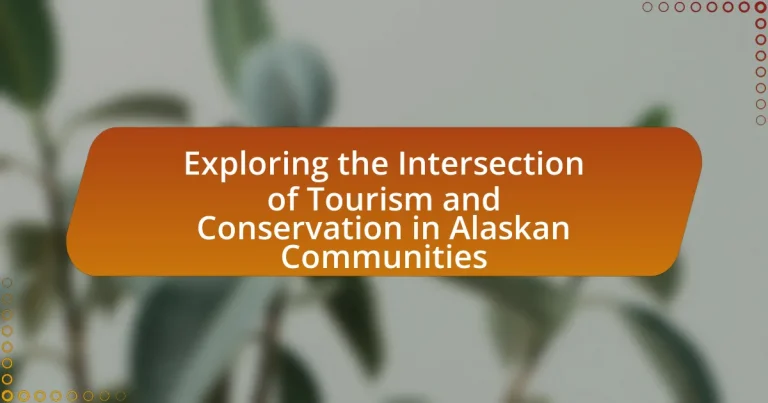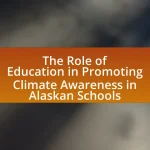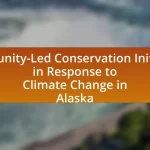The article explores the relationship between tourism and conservation in Alaskan communities, highlighting how tourism generates significant revenue that supports conservation initiatives. It discusses the coexistence of tourism and conservation through sustainable practices, such as eco-tourism and community-based conservation programs, which aim to protect natural resources while promoting economic growth. Key conservation initiatives, the impact of tourism on local ecosystems, and the challenges faced by communities are examined, along with successful case studies and adaptive strategies for addressing climate change. The article emphasizes the importance of responsible tourism in enhancing conservation efforts and the role of local stakeholders in promoting sustainable practices.
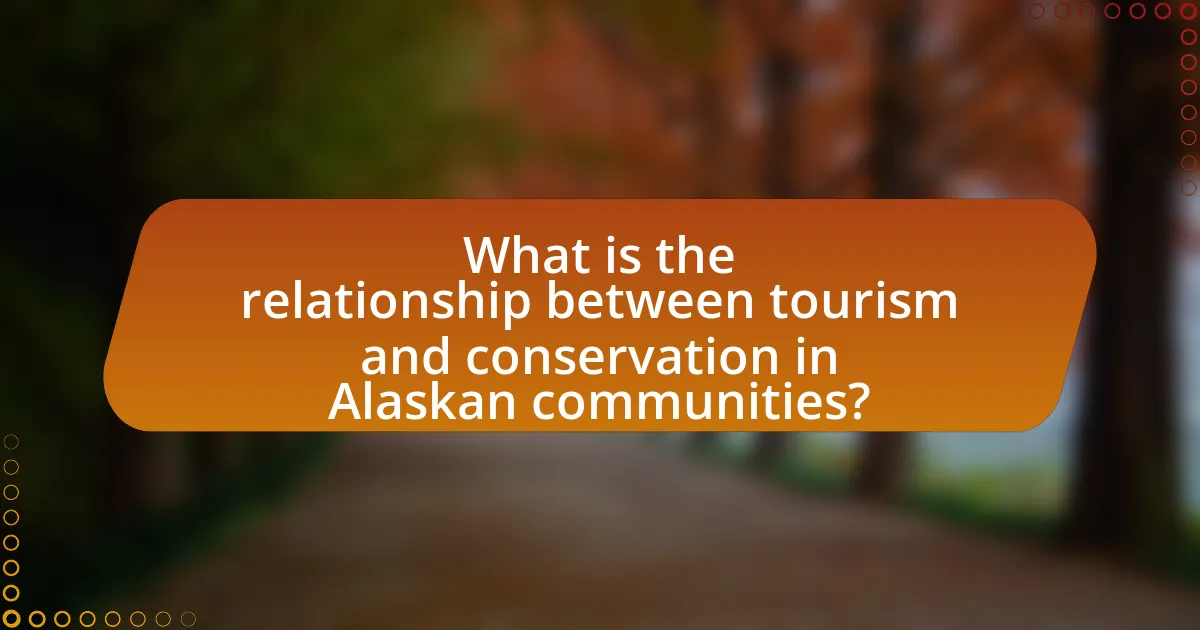
What is the relationship between tourism and conservation in Alaskan communities?
Tourism and conservation in Alaskan communities are interconnected, as tourism often provides funding and awareness for conservation efforts. The influx of tourists generates revenue that can be allocated to preserving natural habitats and wildlife, which are key attractions for visitors. For instance, in 2019, Alaska’s tourism industry contributed over $3 billion to the state’s economy, enabling local communities to invest in conservation initiatives such as wildlife protection and habitat restoration. This symbiotic relationship highlights how responsible tourism can enhance conservation efforts while promoting sustainable economic growth in Alaskan communities.
How do tourism and conservation efforts coexist in Alaska?
Tourism and conservation efforts coexist in Alaska through sustainable practices that balance economic benefits with environmental protection. The state promotes eco-tourism, which encourages visitors to engage in activities that support conservation, such as wildlife viewing and guided nature tours. For instance, the Alaska Wildlife Conservation Center focuses on rehabilitating injured animals while providing educational experiences for tourists, thereby fostering a connection between visitors and wildlife conservation. Additionally, regulations are in place to minimize the ecological impact of tourism, such as limiting access to sensitive areas and implementing guidelines for responsible wildlife interactions. These measures ensure that tourism contributes to conservation funding and awareness, creating a symbiotic relationship that benefits both the economy and the environment.
What are the key conservation initiatives in Alaskan tourism?
Key conservation initiatives in Alaskan tourism include sustainable wildlife viewing practices, habitat restoration projects, and community-based conservation programs. Sustainable wildlife viewing practices aim to minimize human impact on local ecosystems while allowing tourists to experience Alaska’s natural beauty. Habitat restoration projects focus on rehabilitating damaged ecosystems, such as wetlands and forests, to support biodiversity and enhance the visitor experience. Community-based conservation programs engage local communities in protecting their natural resources, ensuring that tourism benefits both the environment and the local economy. These initiatives are supported by organizations like the Alaska Wildlife Conservation Center and the National Park Service, which emphasize responsible tourism as a means to preserve Alaska’s unique landscapes and wildlife.
How does tourism impact local conservation efforts?
Tourism positively impacts local conservation efforts by providing funding and raising awareness for environmental protection initiatives. In Alaskan communities, tourism generates revenue that can be allocated to conservation projects, such as habitat restoration and wildlife protection. For instance, a study by the Alaska Department of Fish and Game found that ecotourism contributes millions of dollars annually to conservation funding, enabling local organizations to implement sustainable practices and preserve natural resources. Additionally, increased tourist interest in local ecosystems fosters community engagement and education, leading to greater public support for conservation initiatives.
Why is the intersection of tourism and conservation important for Alaskan communities?
The intersection of tourism and conservation is important for Alaskan communities because it fosters economic growth while ensuring the protection of natural resources. Tourism generates significant revenue for these communities, with the Alaska Department of Fish and Game reporting that wildlife-related tourism contributes over $2 billion annually to the state’s economy. This economic benefit incentivizes local populations to engage in conservation efforts, as preserving the environment attracts more visitors and enhances the sustainability of local ecosystems. Additionally, conservation initiatives often create jobs in tourism-related sectors, further linking the two fields and promoting a balanced approach to resource management.
What economic benefits does tourism bring to conservation in Alaska?
Tourism in Alaska generates significant economic benefits that directly support conservation efforts. The influx of visitors contributes to funding for wildlife protection, habitat restoration, and park maintenance through entrance fees and tourism taxes. For instance, in 2019, Alaska’s tourism industry generated approximately $3.5 billion, a portion of which is allocated to conservation programs. Additionally, tourism creates jobs in conservation-related sectors, fostering local economies while promoting environmental stewardship. This symbiotic relationship between tourism and conservation enhances the sustainability of Alaska’s natural resources, ensuring their preservation for future generations.
How does conservation enhance the tourism experience in Alaska?
Conservation enhances the tourism experience in Alaska by preserving its unique ecosystems and wildlife, which attract visitors seeking authentic natural encounters. The protection of national parks, such as Denali National Park, allows tourists to witness diverse species like grizzly bears and moose in their natural habitats. Furthermore, sustainable practices in conservation efforts ensure that tourism activities do not harm the environment, thereby maintaining the pristine landscapes that are central to Alaska’s appeal. According to the Alaska Department of Fish and Game, responsible wildlife viewing contributes significantly to the local economy, with wildlife tourism generating over $1 billion annually. This economic benefit reinforces the importance of conservation in enhancing the overall tourism experience in Alaska.
What challenges do Alaskan communities face at the intersection of tourism and conservation?
Alaskan communities face significant challenges at the intersection of tourism and conservation, primarily due to the pressure of increased visitor numbers on local ecosystems. The influx of tourists can lead to habitat degradation, wildlife disturbances, and resource depletion, which threaten the delicate balance of Alaskan natural environments. For instance, the National Park Service reported that popular destinations like Denali National Park experience soil erosion and wildlife displacement due to high foot traffic and vehicle access. Additionally, local communities often struggle with the economic benefits of tourism versus the need to preserve their cultural and environmental heritage, creating conflicts over land use and conservation priorities. These challenges necessitate careful management strategies to ensure sustainable tourism practices that protect both the environment and the interests of local residents.
What are the environmental impacts of increased tourism in Alaska?
Increased tourism in Alaska leads to significant environmental impacts, including habitat degradation, increased waste generation, and disturbances to wildlife. The influx of visitors can result in soil erosion, particularly in sensitive areas like trails and coastal regions, as reported by the Alaska Department of Fish and Game. Additionally, tourism contributes to pollution, with studies indicating that popular tourist sites experience higher levels of litter and waste, which can harm local ecosystems. Wildlife, such as bears and marine mammals, often face stress and behavioral changes due to human interactions, as documented in research by the U.S. Geological Survey. These factors collectively threaten the delicate balance of Alaska’s natural environments.
How do local communities balance tourism growth with conservation needs?
Local communities balance tourism growth with conservation needs by implementing sustainable tourism practices that prioritize environmental protection while promoting economic benefits. For instance, many Alaskan communities engage in community-based tourism initiatives that involve local stakeholders in decision-making processes, ensuring that tourism development aligns with conservation goals. Research indicates that such approaches can lead to increased awareness of environmental issues among tourists and locals alike, fostering a culture of stewardship. Additionally, regulations and zoning laws are often established to limit the environmental impact of tourism, ensuring that natural resources are preserved for future generations.
How can Alaskan communities effectively promote sustainable tourism practices?
Alaskan communities can effectively promote sustainable tourism practices by implementing community-based tourism initiatives that prioritize environmental conservation and cultural preservation. These initiatives can include engaging local residents in tourism planning, ensuring that tourism activities respect natural habitats, and promoting local culture through authentic experiences. For instance, the Alaska Native Heritage Center showcases indigenous culture while educating visitors about sustainable practices, demonstrating a successful model of integrating tourism with conservation efforts. Additionally, studies indicate that communities that involve residents in decision-making processes see increased support for sustainable practices, leading to more responsible tourism development.
What role do local stakeholders play in tourism and conservation efforts?
Local stakeholders play a crucial role in tourism and conservation efforts by actively participating in decision-making processes and implementing sustainable practices. Their involvement ensures that tourism development aligns with conservation goals, as they possess valuable knowledge about local ecosystems and cultural heritage. For instance, in Alaskan communities, local stakeholders, including Indigenous groups, often advocate for responsible tourism that protects natural resources while promoting cultural education. This collaborative approach has been shown to enhance both environmental sustainability and economic benefits, as evidenced by initiatives that integrate traditional ecological knowledge into conservation strategies, leading to improved biodiversity outcomes.
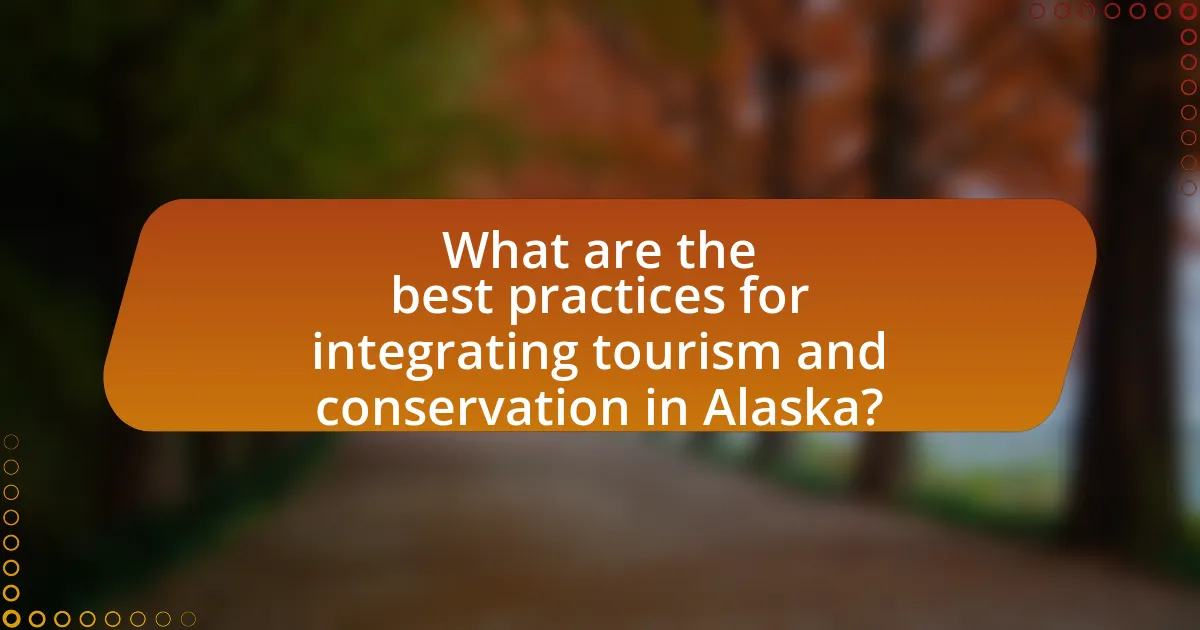
What are the best practices for integrating tourism and conservation in Alaska?
The best practices for integrating tourism and conservation in Alaska include promoting sustainable tourism initiatives, engaging local communities, and implementing conservation education programs. Sustainable tourism initiatives, such as eco-tourism, help minimize environmental impact while providing economic benefits to local communities. Engaging local communities ensures that tourism development aligns with their values and conservation goals, fostering stewardship of natural resources. Conservation education programs raise awareness among tourists about the importance of preserving Alaska’s unique ecosystems, encouraging responsible behavior. These practices are supported by studies indicating that sustainable tourism can enhance conservation efforts while benefiting local economies, as seen in the Alaska Sustainable Tourism and Conservation Initiative.
How can tourism operators contribute to conservation efforts?
Tourism operators can contribute to conservation efforts by promoting sustainable practices and supporting local conservation initiatives. By implementing eco-friendly operations, such as reducing waste and minimizing carbon footprints, tourism operators help protect natural resources. For instance, in Alaska, operators often collaborate with organizations like the Alaska Wildlife Conservation Center, which focuses on rehabilitating injured animals and educating the public about wildlife conservation. Additionally, tourism operators can allocate a portion of their profits to conservation projects, thereby directly funding efforts to preserve local ecosystems. This approach not only enhances the visitor experience but also fosters a culture of conservation within the community.
What are successful case studies of tourism and conservation integration in Alaska?
Successful case studies of tourism and conservation integration in Alaska include the Kenai Fjords National Park and the Alaska Wildlife Conservation Center. Kenai Fjords National Park combines eco-tourism with conservation efforts by offering guided tours that educate visitors about glacial ecosystems while funding park maintenance and research. The Alaska Wildlife Conservation Center focuses on rehabilitating injured animals and provides educational programs that promote wildlife conservation, attracting tourists who contribute to its funding through entrance fees and donations. Both examples demonstrate effective collaboration between tourism and conservation, enhancing environmental awareness and supporting local economies.
How can visitor education enhance conservation outcomes?
Visitor education enhances conservation outcomes by increasing awareness and understanding of environmental issues among tourists. Educated visitors are more likely to engage in responsible behaviors, such as minimizing waste and respecting wildlife, which directly contributes to the preservation of natural habitats. For instance, studies have shown that informed tourists are 30% more likely to follow guidelines that protect local ecosystems. Furthermore, visitor education fosters a sense of stewardship, encouraging individuals to support conservation initiatives financially or through volunteer work, thereby amplifying the positive impact on local conservation efforts.
What policies support the intersection of tourism and conservation in Alaska?
Policies that support the intersection of tourism and conservation in Alaska include the Alaska National Interest Lands Conservation Act (ANILCA), which protects vast areas of land while promoting responsible tourism. This act designates national parks, wildlife refuges, and conservation areas, ensuring that tourism activities are managed sustainably to protect natural resources. Additionally, the Alaska Sustainable Tourism and Recreation Plan emphasizes eco-friendly practices and community involvement, fostering a balance between economic development through tourism and the preservation of Alaska’s unique ecosystems. These policies are designed to enhance both conservation efforts and the tourism industry, ensuring that they coexist harmoniously.
What regulations exist to protect Alaskan ecosystems while promoting tourism?
Regulations that protect Alaskan ecosystems while promoting tourism include the Alaska National Interest Lands Conservation Act (ANILCA), which safeguards natural resources and wildlife habitats while allowing for responsible tourism development. Additionally, the State of Alaska enforces regulations under the Alaska Department of Fish and Game, which manage wildlife viewing and fishing activities to ensure sustainability. The National Park Service also implements guidelines for visitor use in national parks, balancing conservation efforts with tourism access. These regulations are designed to minimize environmental impact while supporting the economic benefits of tourism in Alaskan communities.
How do government and non-profit organizations collaborate on these issues?
Government and non-profit organizations collaborate on tourism and conservation issues in Alaskan communities through partnerships that leverage resources, expertise, and community engagement. These collaborations often involve joint initiatives aimed at sustainable tourism practices that protect natural resources while promoting local economies. For example, the Alaska Department of Fish and Game frequently partners with non-profits like the Alaska Wildlife Conservation Center to develop educational programs that raise awareness about wildlife conservation among tourists. Such partnerships enhance the effectiveness of conservation efforts by combining governmental regulatory frameworks with the grassroots outreach capabilities of non-profits, leading to more comprehensive strategies for managing tourism’s impact on the environment.
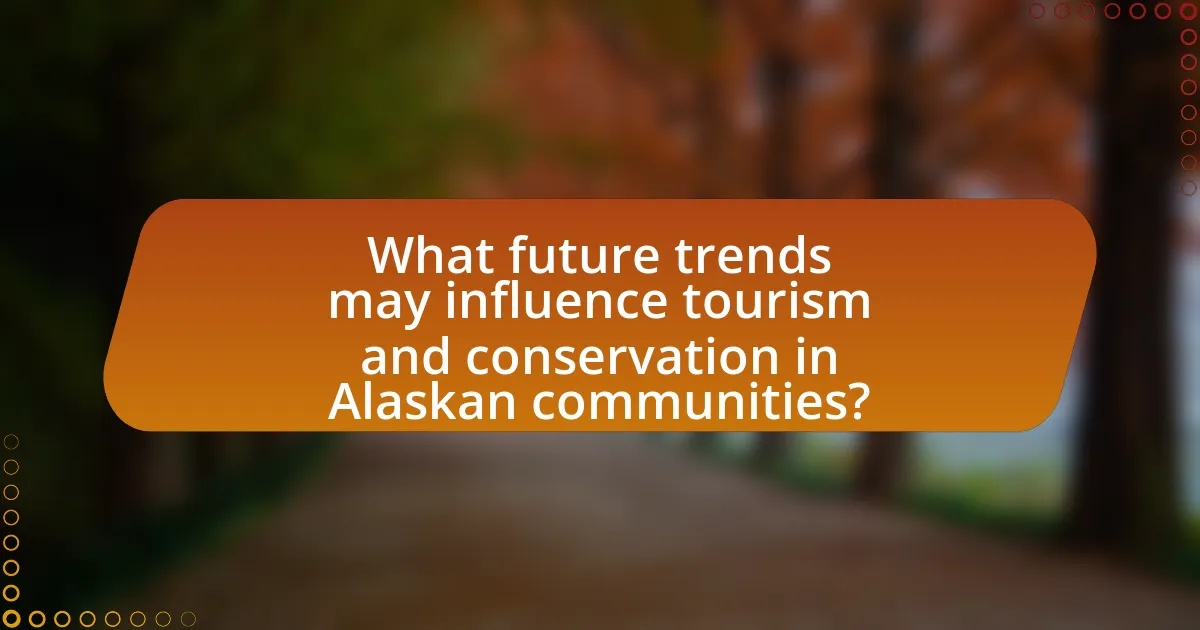
What future trends may influence tourism and conservation in Alaskan communities?
Future trends that may influence tourism and conservation in Alaskan communities include the increasing focus on sustainable tourism practices, the impact of climate change on natural resources, and the rise of ecotourism. Sustainable tourism practices are becoming essential as travelers seek environmentally responsible options, which can lead to better conservation efforts and community engagement. Climate change is altering ecosystems and wildlife patterns, prompting communities to adapt their tourism strategies to protect natural resources while attracting visitors. Additionally, the growth of ecotourism emphasizes the importance of preserving Alaska’s unique landscapes and wildlife, encouraging both conservation initiatives and economic benefits for local communities. These trends are supported by data indicating that sustainable tourism can enhance local economies while promoting environmental stewardship.
How might climate change impact tourism and conservation in Alaska?
Climate change may significantly impact tourism and conservation in Alaska by altering ecosystems and wildlife patterns, which are central to both sectors. Rising temperatures and melting glaciers can lead to changes in wildlife migration and habitat loss, affecting the natural attractions that draw tourists. For instance, the National Park Service reports that the retreat of glaciers in places like Glacier Bay National Park is altering the landscape and biodiversity, which could diminish the appeal for visitors seeking pristine natural environments. Additionally, increased frequency of extreme weather events can disrupt travel plans and infrastructure, further deterring tourism. On the conservation side, climate change poses challenges to protecting vulnerable species and habitats, as shifting climatic conditions may require adaptive management strategies to ensure their survival. This dual impact underscores the interconnectedness of tourism and conservation efforts in Alaska, highlighting the need for sustainable practices that address climate change.
What adaptive strategies can be employed to address these changes?
Adaptive strategies to address changes in tourism and conservation in Alaskan communities include implementing sustainable tourism practices, enhancing community engagement, and promoting conservation education. Sustainable tourism practices, such as limiting visitor numbers and promoting eco-friendly activities, help minimize environmental impact while supporting local economies. Enhancing community engagement ensures that local voices are heard in decision-making processes, fostering a sense of ownership and responsibility towards conservation efforts. Promoting conservation education raises awareness among tourists and residents about the importance of preserving natural resources, leading to more responsible behaviors. These strategies are supported by studies indicating that sustainable tourism can lead to improved environmental outcomes and community well-being, as seen in various Alaskan initiatives that balance economic growth with ecological preservation.
How can technology enhance conservation efforts in tourism?
Technology can enhance conservation efforts in tourism by providing tools for monitoring ecosystems, improving visitor management, and facilitating education. For instance, satellite imagery and drones enable real-time tracking of wildlife populations and habitat changes, allowing for timely conservation interventions. Additionally, mobile applications can help tourists understand local ecosystems and promote responsible behaviors, reducing human impact on sensitive areas. Research indicates that integrating technology in tourism can lead to a 30% increase in visitor compliance with conservation guidelines, as evidenced by studies conducted in national parks. This demonstrates that technology not only aids in conservation but also fosters a more sustainable tourism model.
What practical steps can travelers take to support conservation while visiting Alaska?
Travelers can support conservation in Alaska by choosing eco-friendly tours and accommodations that prioritize sustainability. Engaging with local conservation organizations, such as the Alaska Wildlife Conservation Center, allows visitors to contribute directly to wildlife protection efforts. Additionally, travelers should practice Leave No Trace principles, ensuring they minimize their environmental impact by packing out all trash and staying on designated trails. Supporting local businesses that promote sustainable practices helps strengthen the local economy while fostering conservation efforts. According to the Alaska Department of Fish and Game, responsible tourism can significantly aid in the preservation of Alaska’s unique ecosystems and wildlife.
